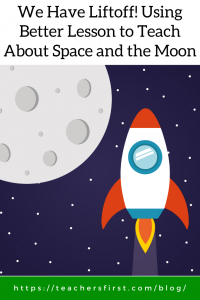Did you know that dust busters, wireless headsets, and invisible braces link back to inventions initially intended for use in space? This interesting USA Today article shares more everyday innovations created for space use. July 20 is Space Exploration Day and Moon Day, which coincides with the annual commemoration of the first moon landing in 1969, Apollo 11’s historic first.
The Next Generation Science Standards include many different contexts for learning about the moon. In younger grades, learning about the moon begins with observations and understandings of the moon’s place in space and the universe. Middle school students begin to explore lunar cycles, eclipses, and using data and graphs to look at patterns in space. As high school students study space, they apply evidence and scientific reasoning, using earth and space materials to understand the movement of the earth, the formation of the planet, and its early history.
Developing high-quality lessons that meet standards and provide students with opportunities to explore and understand more significant concepts takes time. One starting point for first-rate lessons to use and adapt is Better Lesson (reviewed here). Better Lesson contains a sizeable instructional resource library that includes free lessons, resources, and strategies developed by master teachers.
All of the lessons found on Better Lesson are correlated to and searchable by English, Math, and Science standards. Each lesson begins with a stated objective and explanation of the “Big Idea” and include all materials needed, such as links to videos, downloadable templates and worksheets, and additional information. Many lessons have teaching strategies embedded within activities and completed student examples.
A search of Better Lesson to find activities related to the moon delivers 275 lessons and three strategies for all grade levels. Many of the site’s users have saved these examples as favorites, and they provide an excellent starting point for grade-level appropriate lessons.
Early Elementary Lessons:
- The Man in the Moon – This spacewalk activity takes students outdoors to complete observations and incorporates a non-standard measurement math activity. The warmup for this lesson includes a KLEWS (what we know, new learning, evidence and observation, what we wonder, science information) chart schema activator. Students complete the KLEWS chart in closing.
- Moon Phases – This lesson explores the phases of the moon using an anchor chart and a hands-on activity where students use rice to illustrate the four main moon phases.
Upper Elementary Lessons:
- Cosmically Cool Planet Research – This 10-day, inquiry-based planet research project includes a PDF packet for the entire project and incorporates many Language Arts integrations. Engage students with an included PowerPoint presentation.
- Weight, Mass, and Gravity – Students explore why astronauts jump higher on the moon than on Earth in this inquiry-based lesson that includes many examples of student work and conference videos.
Middle School Lessons:
- Phases of the Moon – This lesson uses a strategy known as the Association Triangle Strategy to help students associate three keywords from the lesson. Students create and label a diagram that shows and identifies the moon phases and finish with a formative assessment writing activity.
- Return to the Moon – This resource integrates reading and science activities by having students annotate articles in small groups using shared strategies and includes links to articles with different Lexile levels allowing for differentiation. An after-reading activity takes students through strategies for building skills and strengthening vocabulary.
High School Lessons:
- Tides – Students graph and explore tides in New York City to learn about how tides change due to the moon’s gravitational pull. This lesson begins with a Do Now activity that reviews previous lessons and includes a video, graphing activities, and data analysis. The closing activity is the completion of an exit ticket asking students to reflect on the day’s activity and their understanding of the content.
- Coulomb’s Law and Newton’s Law of Gravitation – This physics lesson introduces Newton’s Law of Gravitation through exploration of the pull of gravity between the Earth and moon. It includes a group work project to determine the force of gravitation based on the distance of the Earth from the moon and incorporates the strategy of peer discussions to help students understand and make corrections to wrong responses.
Although you can use Better Lesson without registering, creating a free account offers users the opportunity to save favorite lessons, strategies, and coaching tips for later use. Use the links within the lessons to share content with others, or click on the tags for individual standards to find additional lessons and strategies that address that standard.
If you need additional ideas for incorporating technology to enhance and extend student learning in this or any content area, consider attending one of the upcoming OK2Ask virtual workshops this summer.
Do you have a favorite Better Lesson or a favorite activity for teaching about the moon and space? Sharing your ideas and comments below helps us all as we work together to improve student learning.


